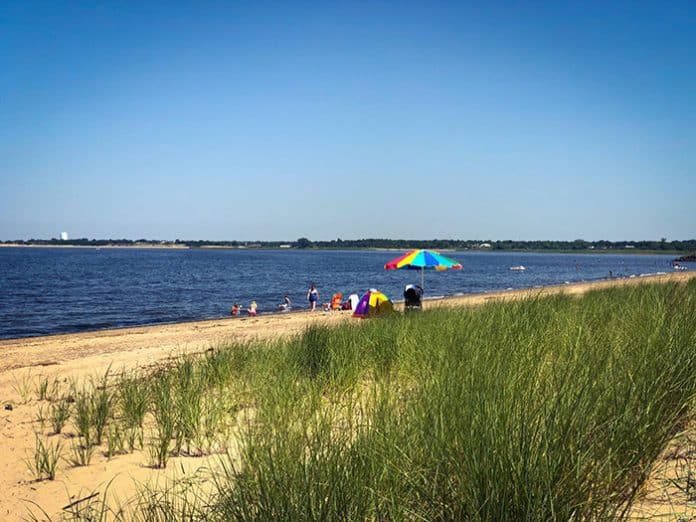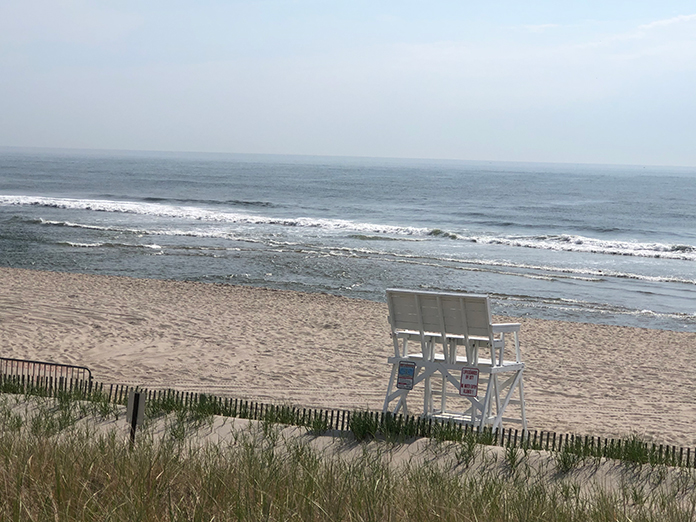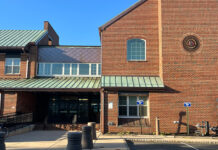
TRENTON – With a heat wave hitting the area this summer, water pollution could close beaches in the state or put swimmers’ health at risk.
Last year, bacteria levels at New Jersey beaches indicated that water was potentially unsafe for swimming on at least 35 days, according to a new report ‘Safe for Swimming?’ by Environment New Jersey Research & Policy Center.
Director of Environment New Jersey Research and Policy Center Doug O’Malley said “one day of a beach closing is too many. We need to keep our beaches safe for swimming by working with shore towns to build the infrastructure that will keep the water clean.
“The shore is packed, especially in a heat wave, and we want to ensure the cleanest possible water quality. Now is the time to provide federal infrastructure funding to ensure that our waters are always safe for swimming by reducing run-off and sewage pollution,” he added.
To assess water quality safety, the group examined whether pathogen indicator bacteria levels exceeded the U.S. Environmental Protection Agency’s (EPA) most protective “Beach Action Value,” which is associated with an estimated illness rate of 32 out of every 1,000 swimmers. In New Jersey, the testing is conducted at 210 ocean and bay beaches.
New Jersey’s state action levels were triggered 35 times in 2020. Notably, the 5th Ave. Bay Front Beach at Seaside Park Borough had 14 exceedances and had bacteria levels above this safety threshold on 47 percent of the days tested last year, more than any other testing site in the state. It also resulted in 12 days of beach closures at this site.
Beachwood West Beach in Beachwood was recorded via NJDEP data (but not EPA data) as having one exceedance before it was closed last July to investigate further pollution sources.
Clean Ocean Action Director Cindy Zipf said “while we’ve come a long way from the hundreds of beach closures in the past, it’s clear there are still problem areas and Clean Ocean Action is developing new programs to help track down and eliminate pollution sources
“This is a remarkable report card for New Jersey’s work to improve beach water quality. However, the program itself is long-overdue for an upgrade,” she added.
The Seaside Park 5th Ave. Bay Front beach, exceedances began in late August, first on August 17 and then again on August 24. This resulted in investigating primary and bracket stations daily until September 2, 2020, and elevated concentrations were still observed.
According to the NJDEP Cooperative Coastal Monitoring Program, an analysis indicated that wildlife was a likely source. The beach reopened in early September and closed for the season the following week.
The closure of Beachwood Beach was early in the season as elevated levels of bacteria were observed in ambient conditions. As early as July, it was decided to close down the beach to allow for source track down investigations.

The beach there is part of the Toms River, and there is little current so the beach tends to close more than others.
These chronic water quality problems are being investigated by a multi-year track down project, with a set of environmental, community and governmental partners, including NJDEP, Clean Ocean Action, Save Barnegat Bay and MATES (Marine Academy of Technology and Environmental Science).
“This problem is on the bayside only. Ocean beaches in Seaside Park are all clean, safe and open. We have had some trouble recently at one bayside beach at 5th Avenue which we suspect is related to the state’s newly installed stormwater pumping stations. We have reached out to all of the agencies involved and environmental groups for assistance and would welcome a collaborative effort to solving the problem. This beach is used by our children and has never had these problems prior to the Route 35 project,” Borough Mayor John A. Peterson Jr. said.
Other beaches in the state found potentially unsafe for swimming at least twice in 2020 included beaches in Long Beach Township (Bay Beach), Surf City (Bay Beach), Lavallette (Bay Beach), Wildwood, Sea Isle City and Cape May. The monitoring with exceedances included 10 testing locations in nine separate communities.
Save Barnegat Bay’s Executive Director Britta Forsberg remarked, “development pressures continue at the Shore and around Barnegat Bay as everyone wants to live by the water. We need the continued support of federal and state dollars to update infrastructure, both green and gray, to keep our home waters fishable and swimmable.”
“Towns like Seaside Park have been good stewards of our beaches and have made significant local investments in a planned living shoreline and water quality project which includes an oyster reef,” Forsberg added.
“The road to safer swimming waters has two lanes. There is a point-source lane that runs through Washington D.C. Lawmakers can choose to fully fund the Clean Water Revolving Fund which helps build and upgrade sewage treatment infrastructure. They can fully fund the BEACH Act as well which pays for all this testing at recreational bathing beaches,” John Weber, Mid Atlantic Regional Manager for the Surfrider Foundation said.
“The non-point-source lane to safer swimming waters depends on thousands of decisions made by individual property owners like when a homeowner decides to install an Ocean Friendly Garden, or when a municipality decides to reduce its stormwater runoff through a low impact development ordinance,” he said.
Polluted runoff from roads and parking lots, overflowing or failing sewer systems, and farms are common sources of contamination that can put swimmers’ health at risk and lead authorities to close beaches or issue health advisories. Scientists estimate 57 million instances of people getting sick each year from contact with polluted waters in the U.S.
Taylor McFarland, Acting Director, Sierra Club New Jersey said, “we’ve been having a hot summer. Folks want to enjoy our beaches, but water pollution continues to threaten the Shore year after year. Stormwater runoff and sewage end up in our bays and ocean, closing beaches for sometimes days at a time.”
“Every year, this report has shown that New Jersey needs to do more to protect our coast and bays from chronic pollution, runoff from fertilizers and sceptics, and old leaky sewer pipes. It’s time for the Murphy Administration and the NJDEP to wake up and smell the sewage,” McFarland said.






